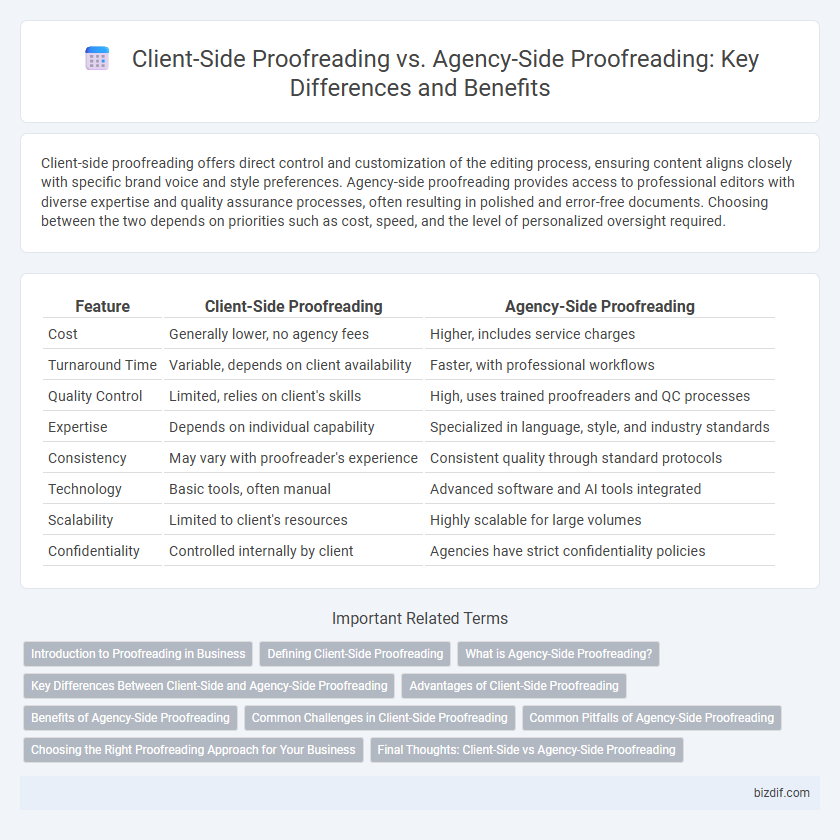Client-side proofreading offers direct control and customization of the editing process, ensuring content aligns closely with specific brand voice and style preferences. Agency-side proofreading provides access to professional editors with diverse expertise and quality assurance processes, often resulting in polished and error-free documents. Choosing between the two depends on priorities such as cost, speed, and the level of personalized oversight required.
Table of Comparison
| Feature | Client-Side Proofreading | Agency-Side Proofreading |
|---|---|---|
| Cost | Generally lower, no agency fees | Higher, includes service charges |
| Turnaround Time | Variable, depends on client availability | Faster, with professional workflows |
| Quality Control | Limited, relies on client's skills | High, uses trained proofreaders and QC processes |
| Expertise | Depends on individual capability | Specialized in language, style, and industry standards |
| Consistency | May vary with proofreader's experience | Consistent quality through standard protocols |
| Technology | Basic tools, often manual | Advanced software and AI tools integrated |
| Scalability | Limited to client's resources | Highly scalable for large volumes |
| Confidentiality | Controlled internally by client | Agencies have strict confidentiality policies |
Introduction to Proofreading in Business
Client-side proofreading involves in-house or individual review processes, ensuring content aligns closely with a brand's voice and internal standards before public release. Agency-side proofreading leverages specialized expertise and external resources to enhance content accuracy, consistency, and professionalism across diverse industries. Both approaches play critical roles in maintaining quality control and minimizing errors in business communications.
Defining Client-Side Proofreading
Client-side proofreading involves the individual or organization requesting the text review, taking responsibility for identifying and correcting errors before publication or distribution. This approach allows direct control over content accuracy and adherence to specific style guidelines unique to the client's brand or project requirements. It contrasts with agency-side proofreading, where external professionals provide an independent quality check and fresh perspective on the material.
What is Agency-Side Proofreading?
Agency-side proofreading involves professional proofreaders employed by agencies who review and refine documents before delivering them to clients. This method ensures a multi-layered quality control process, utilizing specialized expertise and standardized workflows to catch errors missed by client-side checks. Agencies often provide comprehensive linguistic, formatting, and consistency reviews tailored to specific industry standards.
Key Differences Between Client-Side and Agency-Side Proofreading
Client-side proofreading often involves a deep understanding of the specific brand voice and internal style guides, allowing for more tailored and consistent content refinement. Agency-side proofreading tends to offer a broader range of expertise, handling diverse projects across multiple industries with standardized quality assurance processes. Key differences include the level of brand familiarity, turnaround times, and the flexibility to accommodate client-specific requirements versus scalable, process-driven workflows.
Advantages of Client-Side Proofreading
Client-side proofreading offers direct control over the content, ensuring immediate alignment with the brand's tone and messaging. It allows for faster turnaround times by eliminating delays typically involved with agency communication. This method also enhances confidentiality since sensitive materials remain within the organization, reducing the risk of external data breaches.
Benefits of Agency-Side Proofreading
Agency-side proofreading offers access to specialized expertise and a team of seasoned professionals, ensuring higher accuracy and consistency across diverse content types. Centralized quality control in agencies leads to refined style adherence and faster turnaround times due to established workflows. Clients benefit from scalable services and integrated feedback mechanisms that improve overall editorial quality.
Common Challenges in Client-Side Proofreading
Client-side proofreading often faces challenges such as limited expertise in specialized language and inconsistent quality control due to lack of professional training. Time constraints and multitasking responsibilities can lead to overlooked errors and superficial reviews. Reliance on internal resources without fresh perspectives increases the risk of bias and reduces overall proofreading accuracy.
Common Pitfalls of Agency-Side Proofreading
Agency-side proofreading often suffers from miscommunication due to intermediaries, leading to overlooked client-specific preferences and industry jargon. Inconsistent quality control and tight project deadlines contribute to errors that could diminish the final output's accuracy and tone. Lack of direct client interaction further exacerbates misunderstandings, increasing the risk of revisions and client dissatisfaction.
Choosing the Right Proofreading Approach for Your Business
Client-side proofreading enables businesses to maintain direct control over quality and brand voice, leveraging in-house expertise for specialized content. Agency-side proofreading offers access to professional editors with diverse industry experience, ensuring scalability and consistent quality across various projects. Businesses must evaluate factors such as budget, content volume, and desired turnaround time to select the most effective proofreading approach.
Final Thoughts: Client-Side vs Agency-Side Proofreading
Client-side proofreading offers direct control over content accuracy, enabling immediate revisions aligned with the client's specific brand voice. Agency-side proofreading provides access to specialized expertise and standardized quality assurance processes, ensuring consistency across multiple projects. Choosing between the two depends on the need for personalized oversight versus professional scalability and resource availability.
client-side proofreading vs agency-side proofreading Infographic

 bizdif.com
bizdif.com